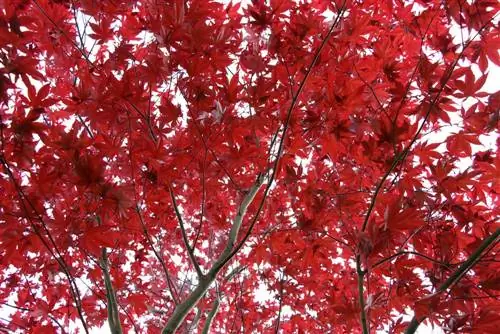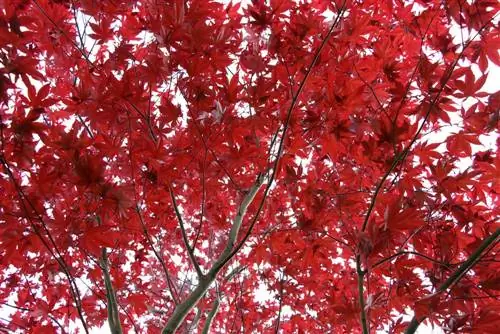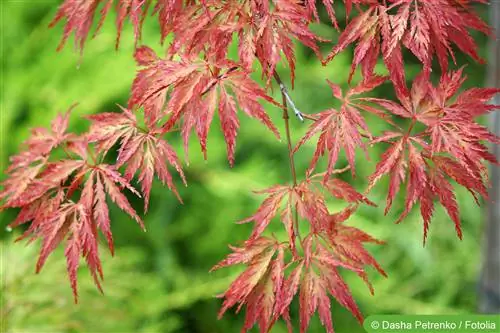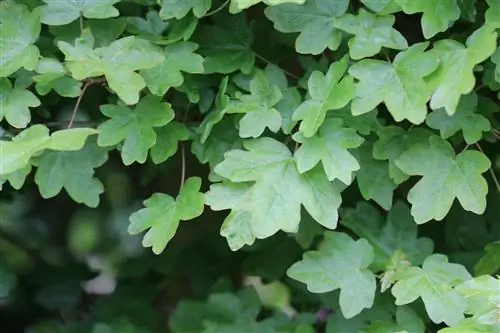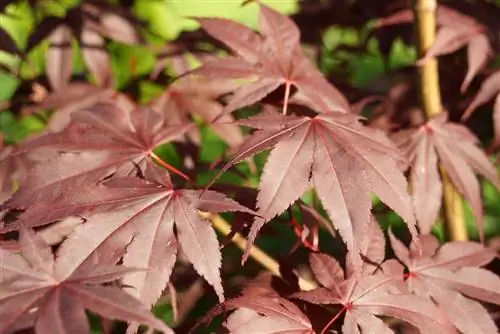- Author admin [email protected].
- Public 2023-12-17 03:39.
- Last modified 2025-01-24 12:45.
The Japanese sloth maple Acer palmatum 'Dissectum Viridis' belongs to the soap tree family and is one of the most beautiful and expressive plants in our gardens. It only grows to around 150 to 200 cm tall. This explains its extraordinary popularity as a potted plant for terraces and balconies. But even in a garden bed it enchants the viewer with its unconventional growth, its slitted leaves and its wonderful colors. However, once a Japanese maple tree is 20 to 25 years old, it can reach a width of a good 3 meters and a height of 5 meters.
It goes without saying that the Japanese maple tree is represented in every Japanese garden. But it is also a very special visual highlight in our gardens thanks to its umbrella-shaped growth and its Asian appearance. It is a valuable ornamental tree for rock gardens, ponds and of course for Japanese gardens.
Location and care
Proper care for the Japanese maple begins with choosing the right location and the optimal composition of the soil. It loves humus-rich, slightly acidic soil. The soil should be moist, but not waterlogged. If it is to be placed outdoors, it feels particularly comfortable on the banks of ponds and streams. Because the slotted maple requires relatively high humidity. However, the blazing midday sun should be avoided. The slotted maple loves partial shade. This is especially true for container planting. The morning and evening sun do not cause any problems for the trees in the planters. However, the vessels must be of sufficient size. In containers that are too small, root damage can quickly occur in very hot summers and cold winters with very low temperatures. In addition, perfect drainage in the planters is important for the survival of the plant. Waterlogging quickly ends in death for the slotted maple.
Cut
Pruning is not absolutely necessary because this tree grows very slowly at 10 to 30 cm per year. However, cutting the slot maple promotes good branching and uniform growth. The optimal cutting time is from May to July. This means the cuts can heal well before winter. Pruning in late summer, autumn or winter should definitely be avoided as it encourages the penetration of pathogens. The cut is always made on annual wood using a clean cutting tool, 1 to 2 cm above a bud or above a side branch. A small residue will remain, which will dry until it dries and can be removed after drying. The cut must be carefully closed immediately with a wound closure agent.
Fertilization & Watering
The slot maple only needs to be fertilized if it shows signs of deficiency. Fertilization in spring with a good commercially available long-term fertilizer is ideal. If possible, rainwater should be used to water the plant pots.
Winter Care
The Japanese maple, like most Japanese maples, is well hardy. However, very cold easterly winds are dangerous. A wind-protected location is therefore advisable. It can tolerate temperatures down to minus 10° C. However, since it has shallow roots, it is good if the roots are protected with mats, foil or Styrofoam. Its roots lie directly beneath the earth's surface and are therefore exposed to the extreme winter temperatures. This is particularly true for pot planting. These should therefore be moved to a place protected from frost, placed on wooden slats or on Styrofoam and covered with a thermal insulation fleece.
Diseases
The Japanese maple tree can be affected by verticillium wilt. This is a fungal disease whose pathogens are found in the soil. They reach the entire tree via the roots. Droopy leaves and dead branches indicate an infestation. Unfortunately, the maple can no longer be saved because there is no fungicide to stop this fungus. Even a cut won't save you. However, with the right location and well-prepared soil, this infestation can be prevented.
Propagate
The Japanese maple is relatively easy to propagate through cuttings.
- Soft, not yet or at least only slightly woody cuttings are cut
- and then inserted into lava granules with a grain size of 1mm
- The number of leaves is reduced to two to three leaves to prevent evaporation from the leaves
- Shoot tips must be cut away
- Jiffy pots are well suited as containers for the cuttings
- sometimes a hormone can be helpful for rooting
- a warm, humid environment promotes rooting
- place brightly, but not in the sun
- the substrate should be kept moist but not wet
- After about 8 weeks, small roots have formed
- The best time for propagating cuttings is from the end of May to the end of June
Frequently asked questions
My slot maple is getting leaf browning. What did I do wrong?
The causes of leaf browning can be too much moisture or too much drying out. Bright midday sun and a very cold easterly wind also damage the plant. Once the cause has been remedied, the maple can recover.
My little maple initially had very beautiful leaves. Now he has lost them all. One shoot after another breaks. What did I do wrong?
The cause of the shoots dying is probably waterlogging. Every planter must have a drainage layer in the pot. Water from the saucer must be emptied so that the tree never stands in water. Repot, add a drainage layer to the bottom of the pot and wait to see whether the maple recovers.
What you should know about slot maple in brief
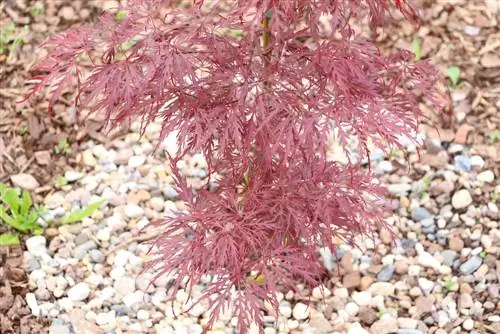
The slot maple is available in different colors. But that doesn't mean that this is a colorful tree that can be purchased in the most unusual colors. Rather, this refers to the color of the foliage. In addition to the normal green coloring of the leaves, you can also get red-leaved slot maple in different shades. The slotted maple is therefore not only very popular in private gardens. It can also often be found in parks. The Japanese maple tree is almost always present in Japanese gardens.
- In Germany, the slotted maple is a popular potted plant for balconies, terraces and gardens.
- It is also possible to place the slotted maple outdoors.
- The slot maple does not grow particularly large. It is more likely to be classified in the shrub category.
- It reaches a height of 150 to 200 cm. But it is more broad. Ages up to 300 cm.
Care
In order for the slotted maple to maintain its beautiful shape, it must be cared for regularly. Proper care begins with choosing the right location and the optimal soil composition. The slotted maple loves humus-rich soil, which should also be slightly acidic. In addition, he wants it to be moist, but at the same time there should be no waterlogging. If the slotted maple is not intended as a container plant, it feels very comfortable on the banks of ponds and streams.
Location
- The slotted maple is not necessarily a lover of full sun, it prefers partial shade.
- Morning or evening sun are not problematic, but a location in the blazing midday sun should be avoided.
Fertilize
- Fertilizing is not absolutely necessary.
- If the slot maple shows deficiency symptoms, then fertilization can help.
- Watering should always be done with rainwater.
Wintering
- The slotted maple can withstand temperatures down to -10 °C.
- However, in this case the roots should be protected with Styrofoam, foil or something similar.
- The tree has shallow roots. The roots lie directly beneath the surface of the earth.
- Slotted maple is not winter-proof in extreme temperatures.
- A potted plant should therefore be moved to a protected location in good time before frost.

